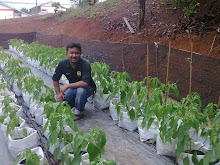Fertigation Methods
Fertigation, as the name implies, is the applying of fertilizers through irrigation water: Fertilization + Irrigation. This relatively new technique is being more and more commonly used in recent years, but the term "fertigation" is still not well recognized and many have not heard it.
Fertigation has many advantages over other fertilization methods, and when properly used, it saves time and labor, fertilizers application is more accurate and uniform, and nutrient uptake by roots is improved.
Two methods of fertigation: quantitative and proportional
When using fertigation, fertilizfers solutions are prepared in advance in stock tanks and the solution is then injected into the irrigation water. The most common fertigation methods to do so are the quantitative method and the proportional method.
The quantitative method is commonly used in soils. In this fertigation method, the grower first decides how much fertilizer he needs to apply per area (e.g. kg/ha, lbs/acre). This quantity of fertilizer is then delivered through the irrigation system.
The proportional method is mostly used in soil-less media and sandy soils. In this method a defined quantity of the stock solution is injected into each unit of water flowing through the irrigation system (e.g. l/m3, lbs/gal).
Some fertigation controllers allow the grower to directly determine the required injection rate, while other controllers require the input of time and flow parameters (irrigation flow rate, irrigation duration, injector discharge, injection duration).
Irrigation system design for fertigation
Effective fertigation requires knowledge and proper management. In fertigation, fertilizing is an integral part of the irrigation system and therefore, the irrigation system has to be properly designed. Here are some examples to be taken into consideration for a good design:
Irrigation flow rate should correlate to the injector discharge. For example, if the irrigation flow rate is too high, it won't be possible to inject the full amount of the needed fertilizer.
Installing one-way valves in appropriate places in the system prevents back flow of fertilizers to the pumps or into drinking-water lines.
Water meters installation is highly important.
The whole system should be well calibrated, including injectors, water meters, EC and pH sensors. Inaccurate readings may result in untoward results, damages to the irrigation system and plants and obviously, the efficiency of fertilization is reduced.
Importance of fertilizers solubility in fertigation
Not all fertilizers can be used in fertigation: only water soluble fertilizers are appropriate, but bear in mind that they differ in their solubility under the same conditions. Moreover, the solubility of each fertilizer may change under different pH and temperatures.
Mixing different fertilizers in the same stock tank may also affect their solubility. More importantly, some fertilizers cannot be mixed together because of interactions that result in insoluble salts which clog the irrigation system and reduce the efficiency of fertigation (see Solubility article).
Irrigation system plugging hazard: causes and solutions
Fertigation is commonly practiced using micro-irrigation systems, which are highly susceptible to plugging. The causes of plugging may be particles in the water, precipitation of salts or bacteria and algae growth.
Particles of sand and suspended debris are usually too large to pass through emitters, while silt-sized and clay-sized particles do not normally cause emitters plugging. This kind of plugging hazard can be predicted by measuring turbidity and performing laboratory filtration test. Plugging with sand particles and debris can be prevented by adequate filtration.
In fertigation, the irrigation water contain a relatively high concentration of dissolved salts. If the pH of the irrigation water is above 7.0, or if one or more minerals are in excess, precipitation and emitter plugging is highly probable. Precipitates of Calcium and iron minerals are the most common. Preventing plugging in this case is by keeping the pH of the irrigation water below 7.0 (slightly acidic) and avoiding excessive application of fertilizers, beyond the crop requirements. Flushing the irrigation system before or after each irrigation cycle can also prevent salt accumulation.
High levels of iron and hydrogen sulfide promote growth of bacteria, which create slime. Algae can also create slime. Slime accumulates in different parts of the irrigation system and may cause emitter plugging. Reddish slime indicates presence of iron bacteria, while yellowish to white slime suggests that sulfur bacteria are active. Preventing plugging by slime can be achieved by chlorination. If the source water is not chlorinated, it is a good practice to inject chlorine upstream to the filtration system.
Annual maintenance of the irrigation system is extremely important for keeping the system in good condition.
Guy Sela is an agronomist and a water specialist. In 2005 Guy developed a unique software for fertilizer management that helps growers reach optimal yields, while saving time, money and frustration.
Visit Guy's website at:
http://www.smart-fertilizer.com
Article Source: http://EzineArticles.com/?expert=Guy_Sela


















DRIP IRRIGATION, INTEGRATED DRIP LINES, INLINE LATERAL PIPES, DRIP EMITTERS, FERTIGATION, DRIP IRRIGATION MANUFACTURERS INDIA, INTEGRATED DRIP LINES MANUFACTURERS INDIA, INLINE LATERAL PIPES MANUFACTURERS INDIA, DRIP EMITTERS MANUFACTURERS INDIA, FERTIGATION MANUFACTURERS INDIA to visit more http://www.sujayirrigations.com
Can you please write in english
I gone through your blog. Its really good.very useful information..Thanks for sharing this.
see my products also
Fertigation Manufacturers
Drip emitters manufacturers
Your blog is simply superb. very useful information. Thanks for sharing this.
see my products also
Integrated Drip Lines
Inline lateral pipes in India
Post a Comment